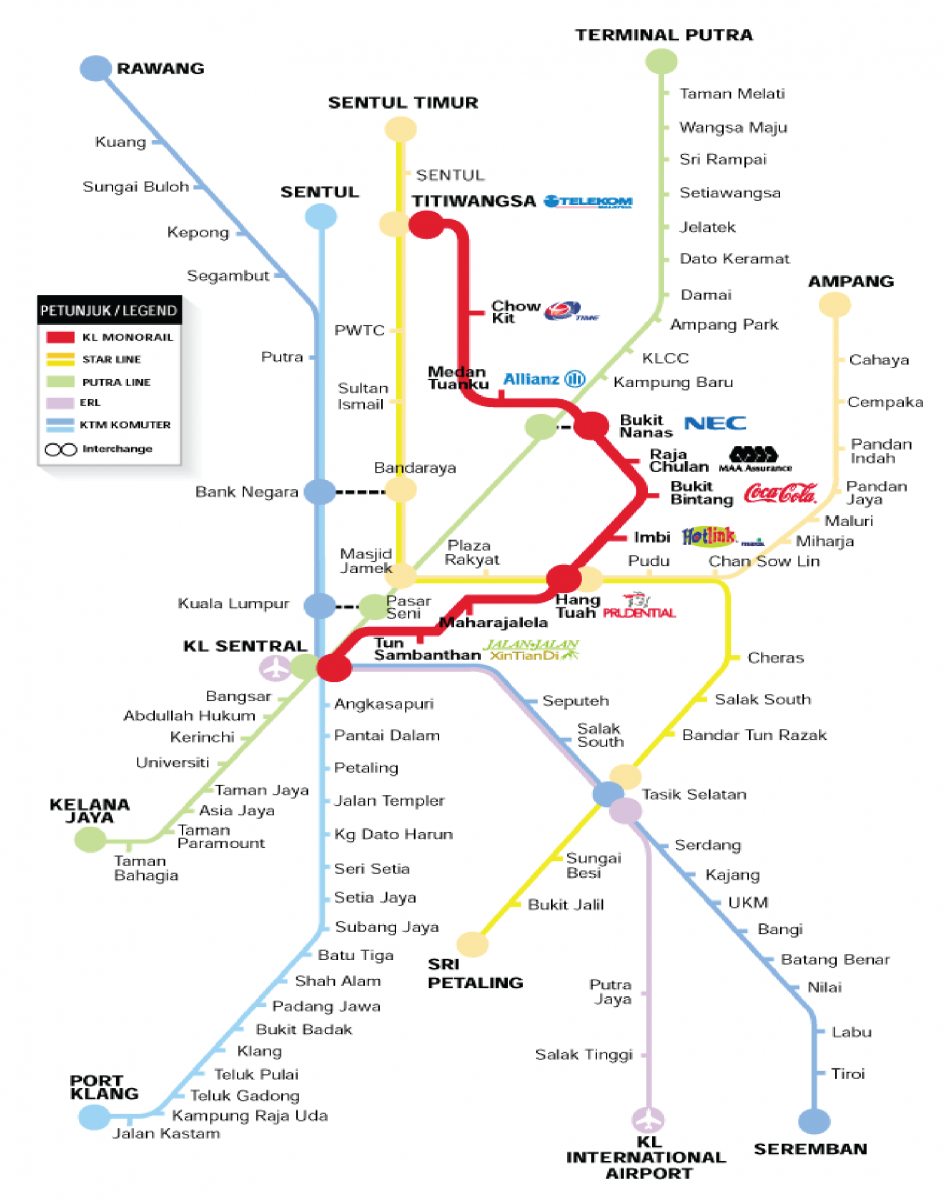| |

|
GETTING AROUND KL
KL has an advanced and well-connected transportation infrastructure. So whether you choose to fly in with Malaysia Airlines or take a ride on any of the Transnasional buses, getting into KL is easy. As the national transportation hub, you can take advantage of KL's network to see the rest of Malaysia and the world.
There are many ways to travel into KL by land. You can either take the bus, train or drive a car and enjoy the scenic views that the country has to offer. Travelling on the road in Malaysia is safe and most transportation services are comfortable and reliable.
Kuala Lumpur is a relatively accessible city with many ways to get around conveniently. There are three major rail networks within the city, a number of air-conditioned buses to all areas in the city, and a fleet of taxis that will take you anywhere you need to go. Nevertheless, the best way to experience the sights and sounds would be to go for a walk around town.
BUSES
There are several bus operators servicing the bus lines in and around the capital. Bus stands are usually available next to train stations and shopping complexes. Fares commonly range between RM 1.00 to RM 3.00, depending on the zone in which the passenger intends to travel to. Passengers are also able to pay for fares using a prepaid card called Touch n' Go, which can be bought at all major train or LRT stations. It is important to note that traffic in KL could be notoriously heavy during peak hours, and bus schedules may not be accurate at all times.
GO-KL CITY BUS
Go-KL City Bus is a free bus service, which is operated by the Land Public Transport Commission (SPAD). These single-decker busses are easily identifiable from its colour (pink) and is a comfortable and convenient option for travellers. The buses operate on two routes, one starting from KLCC and the other from Pasar Seni.
 TAXI Taxis are a common mode of transportation around the city as they are often more versatile than trains. The present fleet of taxis in KL are commonly seen in red or blue. You can identify a taxi via its number plate that starts with the letter 'H'. All taxis in the capital are required to be metered, so the chances of haggling are fairly remote. Passengers should be wary when taxi drivers demand a "fixed fee", and insist on using the meter. Otherwise, walk away and flag down another taxi. Due to traffic jams during peak periods, a taxi ride could take longer than anticipated.
 Reminder Reminder
When riding in taxis always insist that the charge meter is turned on at the beginning of the ride. While most taxi drivers in Kuala Lumpur are honest, there are the few who will demand a fixed rate to get you to your destination. This rate is often double that of the meter rate for the same hourney. TRAINS
KTM KOMUTER The KTM Komuter has 53 stations and consists of two cross-city routes, namely the Sentul-Port Klang and Rawang-Seremban lines. Transfer between the two main lines can be made at KL Sentral, Kuala Lumpur, Bank Negara and Putra stations. Same-platform and cross-platform interchanges are available at the Kuala Lumpur station.
RAPIDKL LRT
The RapidKL LRT has 2 lines; the Ampang Line and Kelana Jaya Line. There are 25 stations on the Ampang Line and 24 stations on the Kelana Jaya Line. Operating hours start form as early as 6am, ending just before midnight daily, with interval frequencies of 3 minutes during rush hours to over 20 minutes during non-peak hours. Fares start from as low as RM0.70 for travelling in between stations within the same zone, and can go up to just over RM5.00 for different zones.
The train serving the Ampang Line starts from the Ampang LRT Station (AG8) and terminates at the Chan Sow Lin LRT Station (AG1/ST1/PH1) where passengers can light. From Chan Sow Lin, passengers can choose to continue their journey to either the Sri Petaling LRT Station (PH8) or the Sentul Timur LRT Station (ST11).
Available transfers along this line are at the Titiwangsa (ST9) and Hang Tuah (ST3) LRT Stations for the Monorail Line, Masjid Jamek LRT Station (ST5) for the Kelana Jaya Line, and Bandar Tasik Selatan LRT Station (PH5) for KLIA Transit or KTM Komuter.
The Kelana Jaya Line starts from the Gombak LRT Station (KJ1) and terminates at the Kelana Jaya LRT.
RAPIDKL MONORAIL
RapidKL Monorail previously known as KL Monorail, is an urban monorail system in Kuala Lumpur, Malaysia. It opened on 31 August 2003, with 11 stations running 8.6 km (5 mi) on two parallel elevated tracks. It connects the Kuala Lumpur Sentral transport hub with the "Golden Triangle"

ON FOOT
Taking the scenic route on foot around KL is a good way to explore the city. Travelers and shoppers in KL can enjoy pedestrian walkways built specifically for their convenience and comfort. One such example is the KLCC Pedestrian Walkway Bridge, which connects Pavilion KL to Impiana KLCC Hotel and the KL Convention Centre. There are also several other pedestrian bridges and walkways that are currently being built at strategic locations in the city. For instance, the Bukit Bintang-KLCC Pedestrian Walkway offers a spectacular view of KL and its modern architecture.
Another newly built covered walkway is one that links the Pasar Seni LRT station to the Pasar Seni building or Central Market. Central Market is a hot spot for unconventional local arts and crafts.
The walkways in KL are built to be friendly to the visually impaired as well as those on wheelchairs.
The streets of KL are already well marked with road signs and all you need is a map. There are also dedicated sidewalks for pedestrians that are shaded by the trees. And do feel free to ask a tourist police or a friendly local for help whenever you need to.

|
|